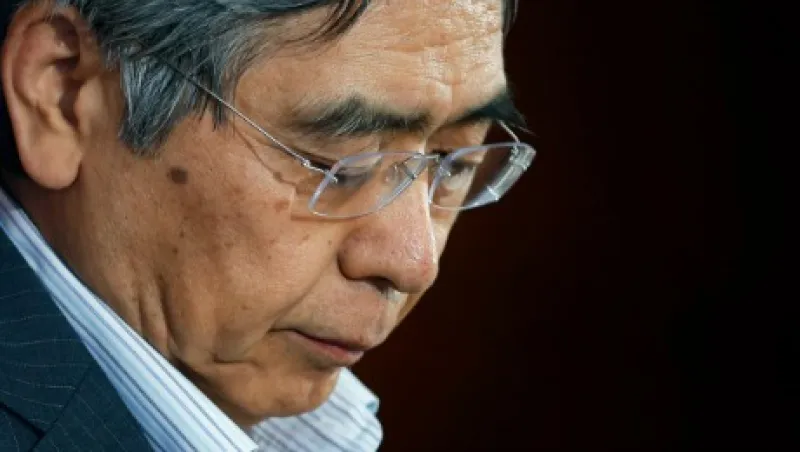Londoners are familiar with the warning to “Mind the gap” (between the train and platform) when they got on or off an Underground train at Bank station, next door to the Bank of England. The central bank itself has to mind the gap — the U.K. output gap, that is. Governor Mark Carney has warned that U.K. interest rates could rise “sooner than markets expect” because the gap between the economy’s potential and actual output has narrowed rapidly, raising the threat of inflation.
Carney has some surprising company in his anxiety about growth and inflation. Haruhiko Kuroda, governor of the Bank of Japan, is also fretting about his country’s rapidly closing output gap, sources close to the central bank say.
Kuroda has staked his professional reputation on ridding Japan of two decades of chronic deflation. He launched a massive program of quantitative easing (QE) last year that deliberately seeks to drive up inflation and, in the process, boost the economy by prompting consumers to buy more and companies to invest. Yet with price pressures and inflation expectations rising smartly in Japan — consumer price inflation hit 1.4 percent in May, and wage rates are beginning to move up — the governor is voicing concerns in private about inflation, according to one former senior BoJ official close to Kuroda.
Some market analysts share that concern. “The risk on Japan’s inflation rate is now on the upside, rather than the downside,” says Tohru Sasaki, head of Japan rates and foreign exchange research at JPMorgan Chase & Co. in Tokyo. “The rate may reach 2 percent sooner than the bank expects.”
Sasaki, formerly the chief foreign exchange dealer at the BoJ, estimates that by the end of April, Japan’s core consumer price inflation rate had reached a rate of 2.2 percent, even after excluding the impact of rising “imputed” rents and a hike in Japan’s national consumption tax on April 1. Many analysts have assumed that inflation would ease from May onward as those one-off factors fade, but Sasaki says planned increases in food, clothing and other prices will continue pushing up the CPI. “There will be a relatively large amount of upside pressure on inflation in coming months,” he says.
A tightening labor market and regulatory and other rigidities that prevent output and productivity from rising in line with demand mean that the gap between actual and potential gross domestic product is narrowing, analysts say. Those factors explain Kuroda’s unease about inflation, as well as the importance he attaches to the government’s program of structural reforms, which are aimed at promoting growth.
On June 24 Prime Minister Shinzo Abe unveiled what he called his “upgraded” New Growth Strategy. It contained a package of structural measures that includes a cut in the corporate tax rate, promotion of corporate governance reforms designed to boost return on equity, an easing of employment regulations and efforts to boost female employment and agricultural productivity. “There will be no taboos and no sacred areas,” Abe said in introducing the measures. “The Abe Cabinet will break through any wall.”
Such structural reforms are popularly known as the “third arrow” of Abenomics, following the first two arrows of fiscal and monetary stimulus. The list of measures was long, but it was noticeably short on time lines for implementation. The lack of a time-bound agenda is likely to throw the onus back onto further monetary easing from the BoJ in order to maintain the momentum of Abenomics in the eyes of market participants, says Jesper Koll, head of research at J.P. Morgan in Tokyo.
One source close to the BoJ sums up Kuroda’s big concern as follows, “If Japan’s growth potential is not enhanced either through official growth policy or by the endeavors of the private sector, Japan could see inflation but no growth.”
Skeptics — and there are plenty of them among private analysts — say that inflation is the last thing Kuroda should be worrying about. They believe he has more reason to fear that inflation will fall short of his 2 percent target once the impact of the weak yen, which causes import prices to rise, fades.
Unless higher prices for imported commodities are passed onto consumers, says a former International Monetary Fund official in Tokyo, “you get a squeeze in value-added and a nasty deflation with currency depreciation.”
BoJ observers say that a noticeably graying Kuroda is also beginning to focus on the challenge of how the BoJ can wind down its purchases of Japanese government bonds, or JGBs, and begin exiting QE once it reaches its inflation target.
“He is trying to infuse a lot of liquidity by purchasing government bonds, but once the inflation target is achieved, maybe he will have to continue monetary easing [at a time when] such huge purchases will not be justified,” says the former BoJ official. “If the government continues to produce such a huge deficit, then inevitably the JGB yield will rise, and if the BoJ stops buying, what will be the outcome? The government might exert tremendous pressure on the BoJ to continue buying even when inflation becomes embedded.”
The BoJ reported in June that it had become the largest single holder of JGBs in the first quarter of this year, overtaking Japanese insurers. Kuroda launched the central bank’s policy of bond purchases in April 2013; it aims to double Japan’s monetary base within two years. With the central bank purchasing as much as 70 percent of new JGB issues, dealers say, liquidity in the government bond market has dried up.
At the same time, Japanese public pension funds have accelerated their sales of JGB holdings. The Government Pension Investment Fund, the world’s biggest pension system with 129 trillion yen ($1.3 trillion) in assets, has been shifting its portfolio, traditionally heavily weighted toward JGBs, into equities.
For now, the BoJ claims not to be worried about the huge expansion of its balance sheet since Kuroda came to office. The central bank’s bond buying is “open ended” in size and not time-bound, say officials at the BoJ.
Far from worrying about the central bank’s exit strategy, most dealers and investors are focusing on the prospect for another round of QE, which many believe is a question of when, not whether.
The one thing “that would elicit an immediate response” from the BoJ is a “turnaround in yen depreciation,” according to the former IMF official. The yen fell by more than 25 percent against the dollar between October 2012 and May 2013 as investors anticipated the impact of Abe’s reforms. Since then, it has traded narrowly around the 100 level. Renewed yen appreciation would be a deflationary force in Japan, the last thing the central bank wants to see. If the BoJ did not react to such a trend, the credibility of its strategy would be lost.






